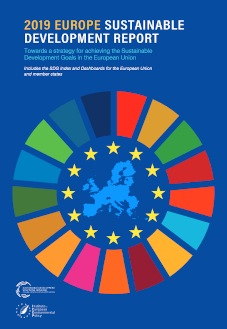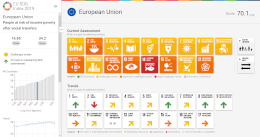
Explore the data
 2019 Europe Sustainable Development Report Interactive SDG Dashboards
2019 Europe Sustainable Development Report Interactive SDG Dashboards2019 Europe Sustainable Development Report Interactive SDG Dashboards
The interactive dashboards provide a visual representation of countries’ performance by SDGs to identify priorities for action.
Download the data
Rankings
| Rank | Country | Score |
| 1 | Denmark | 79.81 |
| 2 | Sweden | 79.44 |
| 3 | Finland | 79.06 |
| 4 | Austria | 76.74 |
| 5 | Germany | 75.35 |
| 6 | France | 74.68 |
| 7 | Netherlands | 71.81 |
| 8 | Czech Republic | 71.77 |
| 9 | Slovenia | 71.74 |
| 10 | Estonia | 70.37 |
| 11 | Belgium | 70.29 |
| 12 | United Kingdom | 70.22 |
| European Union | 70.09 | |
| 13 | Ireland | 68.18 |
| 14 | Spain | 66.76 |
| 15 | Portugal | 66.23 |
| 16 | Poland | 66.15 |
| 17 | Luxembourg | 65.96 |
| 18 | Italy | 65.29 |
| 19 | Slovak Republic | 65.23 |
| 20 | Latvia | 65.23 |
| 21 | Hungary | 65.12 |
| 22 | Croatia | 63.24 |
| 23 | Lithuania | 62.56 |
| 24 | Malta | 62.27 |
| 25 | Greece | 58.90 |
| 26 | Bulgaria | 57.12 |
| 27 | Romania | 55.91 |
| 28 | Cyprus | 54.99 |
Executive Summary
As the new European Commission prepares the European Green Deal, the 2019 Europe
Sustainable Development Report comes at a crucial time, shedding light on the key
economic, social and environmental sustainability challenges faced by the member states
and the European Union as a whole in their progress towards SDGs.
The report finds that:
While European countries lead globally on the SDGs, none are on track to achieve
the Goals by 2030.Countries closest to achieving the SDGs include Denmark, Sweden and Finland,
whereas Bulgaria, Romania and Cyprus rank last among 28 countries assessed.The EU and its member states face the greatest challenges on goals related to
climate, biodiversity, and circular economy, as well as achieving the convergence in
living standards, both within each country as well as across countries and regions.The EU generates large, negative spillovers that impede other countries’ ability to
achieve the SDGs. The largest negative impacts are caused by unsustainable
demand for agricultural, forest, and fishery products.
The report outlines six transformations that together can achieve all 17 SDGs and applies
them to the European Union. It offers practical recommendations for how the EU and its
member states can achieve the SDGs with a focus on three broad areas: internal
priorities, diplomacy and development cooperation, and tackling negative
international spillovers.
The good news is that the necessary instruments already exist to achieve the SDGs
throughout the EU. The new Commission should therefore focus on aligning existing
instruments and mechanisms (including budget, investment strategies, regulatory
governance, monitoring frameworks) with the SDGs.
Key recommendations include:
The European Green Deal can be the cornerstone for implementing the SDGs in the
EU. It must include an EU-wide strategy to (i) fully decarbonise the energy system by
2050; (ii) strengthen the circular economy and achieve greater efficiencies in
resource use and far lower waste; and (iii) promote sustainable land-use and food
systems by 2050.The EU needs to increase public and private investments in sustainable
infrastructure, including power and transport. This in turn will require greater financial
resources for the EU.Europe needs to increase investments in education, job skills, and innovation, with a
focus on STEM education at all levels and R&D for sustainable technologies.The EU needs to put SDGs at the centre of its diplomacy and development cooperation.
The EU needs to strengthen policy coherence and address negative international
spillovers that undermine other countries’ ability to achieve the SDGs.
SDG Index and Dashboards: the methodology
The 2019 Europe Sustainable Development Report details progress by EU and its member
states on their achievement of the Sustainable Development Goals (SDGs). Based on a
methodology that measures distance to target, the report estimates how fast each country –
and the European Union as a whole – have been progressing towards each of the Goals
and determines whether the current pace of progress will be sufficient to achieve them by
2030. In so doing, the European Sustainable Development Report complements the EU’s
official Eurostat report by being able to show how far each country is from achieving SDGs.
The report builds on the methodology developed by the SDSN and Bertelsmann Stiftung to
track countries’ performance on the SDGs since 2016.
The findings of this independent report are consistent with major related publications:
The 2019 Eurostat report, which concludes that Europe was falling behind in terms
of climate action and industry, innovation and infrastructure, while progress was
moderate or mixed on responsible consumption and production, life on land, reduced
inequalities, affordable and clean energy, zero hunger and gender equality.The 2019 GDSR report of the United Nations, which warns against negative long-
term trends for targets, including inequality in income, absolute material footprint and
DMC, global GHG emissions compared with Paris targets, continued deterioration of
coastal waters, overfishing, biodiversity loss, wildlife poaching and trafficking and for
which progress is too slow for SDGs to be met globally (e.g. social protection for all,
ending malnutrition, maintaining genetic diversity, investment in agriculture).The 2018 EEA monitoring report on the 7th European Environmental Action Plan
(EAP), which concludes that 23 out of 30 targets of the 7th EAP were unlikely to be
achieved by 2020, including the reduction of food sector’s environmental impact and
halting of biodiversity loss.
Citation
SDSN & IEEP. 2019. The 2019 Europe Sustainable Development Report. Sustainable Development Solutions Network and Institute for European Environmental Policy: Paris and Brussels
Contact
We welcome suggestions for filling data gaps and for improving the analysis and presentation of the results. Please write to us at info@sdgindex.org.